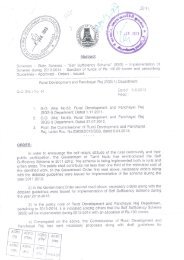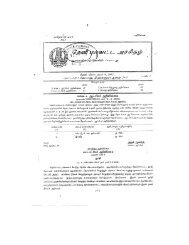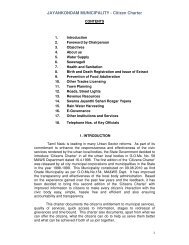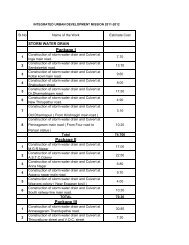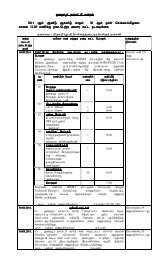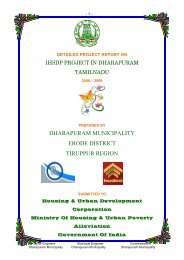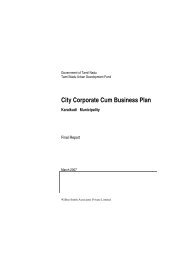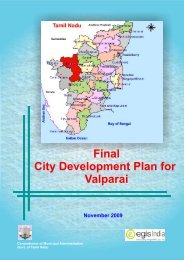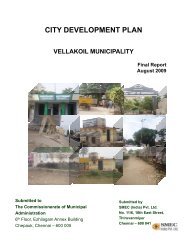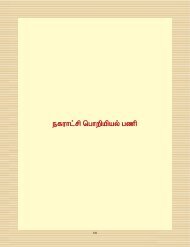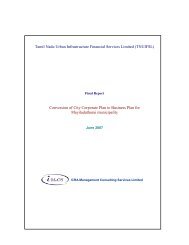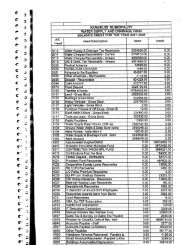Tamil Nadu Urban Infrastructure Financial Services ... - Municipal
Tamil Nadu Urban Infrastructure Financial Services ... - Municipal
Tamil Nadu Urban Infrastructure Financial Services ... - Municipal
You also want an ePaper? Increase the reach of your titles
YUMPU automatically turns print PDFs into web optimized ePapers that Google loves.
6. CMA, GoTN should insist and make ULBs complete accounts closing and audit within 3 months<br />
of completion of financial year. TNUDF could consider a grading system to categorise ULBs on<br />
the basis of quality of accounting and reporting practices.<br />
7. Develop / enforce technical standards with specific applicability to municipal projects<br />
construction and execution particularly in the areas of a) integrated road asset creation and<br />
management, b) Flood management and guidelines for storm water drain construction and c)<br />
Building on ongoing initiatives in Solid Waste Management with greater focus on scientific waste<br />
processing and disposal mechanisms.<br />
8. CMA, GoTN along with TNUIFSL should develop a framework for PPP covering specific<br />
policies and guidelines and model concessions for PPP in urban services including Water supply,<br />
Sanitation, Solid waste management, Street light maintenance and remunerative projects.<br />
9. ULBs should be required to establish the practices of an independent systems audit to be<br />
conducted annually. This would enable ULBs to build in robust processes for disaster recovery<br />
and security of the IT architecture of the ULB.<br />
10. Facilitate creation of a formal institutional mechanism to manage functional overlaps among<br />
nodal agencies/state level agencies and the ULB at the city level.<br />
ULB level<br />
Krish-M could potentially double its own income to Rs.1380 /- lakh by FY ending 2012 through<br />
focused interventions in the following areas. Specific actions for revenue enhancement and<br />
improvement in collection efficiency are outlined in the report.<br />
1. Property tax: – through revision in ARV, widening assessee base and closer scrutiny.<br />
2. Professional tax – sustaining growth in assessments through widening tax base among traders<br />
and self-employed professionals<br />
3. User charges – through increased penetration of water connections and new sewerage<br />
connections could potentially triple user charges income from the current levels.<br />
4. PPP / remunerative projects - Krish-M also needs to explore land development as a revenue<br />
enhancement mechanism and should focus on attracting private sector participation through<br />
appropriate BOT/ SPV structures for implementing remunerative projects.<br />
5. Energy costs - A savings of 15-20% reduction in energy costs appears imminently achievable and<br />
could translate to annual savings of nearly Rs.10-15 lakh<br />
6. Collection Efficiencies in both taxes and user charges indicate scope for improvement.<br />
7. NGOs / Corporate participation - Intensify focus on attracting NGOs/advertising revenue for<br />
city beautification projects to reduce reliance on grants for such projects.<br />
FOP, borrowing capacity and investment capacity<br />
The borrowing capacity of Krishnagiri works out to Rs. 4742 lakh. At an aggregate level, assuming<br />
loans to be equivalent to 50% of investment, sustainable investment capacity works out to Rs. 9484<br />
lakh, which translates to about 56% of the total investment requirement (including slum<br />
rehabilitation). If we exclude slum rehabilitation and urban services for poor projects which are<br />
largely grant funded, the borrowing capacity translates to 74% of the total investment requirement.<br />
CCP cum BP – Krishnagiri <strong>Municipal</strong>ity viii



